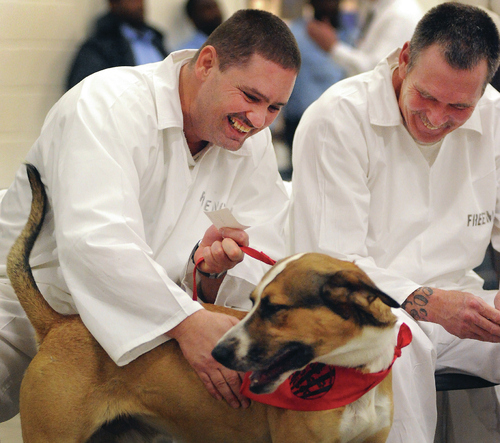Non-Traditional Therapies in Forensic Populations: Benefits of Human-Animal Interaction, Art Therapy, and Meditation-Based Interventions
By
2012, Vol. 4 No. 10 | pg. 1/4 | »
IN THIS ARTICLE
AbstractUnique challenges are present in therapy when working with mentally ill offenders in a correctional setting. In order to encourage effective therapeutic change, hurdles such as strong resistance to therapy by inmates, complex etiologies of illness, and limited resources must be overcome in addition the usual challenges of treating individuals who have psychological issues. The present paper explores how non-traditional therapies, including human-animal interaction, art therapy, and meditation-based interventions have shown great effectiveness in treating mental illnesses common in the forensic population as well as how these three modalities work to mitigate some of the difficulties presented by the aforementioned unique challenges that are not easily accommodated by conventional modalities. Estimates from midyear 2005 revealed that more than half of all individuals in United States jails and prisons present with a mental health problem, defined as either 1) a recent history, or 2) one or more recent symptoms of a mental illness. This statistic represents, specifically, 64% of jail inmates and 56% and 45% of State and Federal prisoners, respectively (James & Glaze, 2006). The most prevalent mental health issues in offender populations are mood and anxiety disorders, substance abuse and dependence, and psychoses. Other illnesses like Antisocial Personality Disorder present in the offender population to lesser degrees as well as miscellaneous symptoms of illnesses that manifest with decreased severity but still significantly impair healthy functioning, such as aggression and social withdrawal (Dettbarn, 2012; James & Glaze, 2006). Additionally, “prisonization” is a concerning set of behaviors widespread among offenders that can impede treatment and reintegration to the general public upon release and, so, must be addressed in effective therapeutic settings (Carr et al., 2006; Dettbarn, 2012).  Effectively treating mentally ill, incarcerated offenders poses a unique challenge to the practitioner. Incarcerated individuals tend to be resistant to treatment for fear that admitting that they need assistance is equivalent to an admission of weakness. The environment of jails and prisons is dangerous to even the healthiest offender. Mentally ill offenders face an increased vulnerability to manipulation and abuse by other inmates and even by correctional staff members, both of whom have been shown to regard mentally ill inmates as devalued human beings. Openly identifying as mentally ill or simply seeking out assistance is a risky prospect that many offenders would rather avoid by, instead, focusing on crafting a tough and intimidating persona in order to avoid potential assaults (Cloyes, 2007). Effectively treating mentally ill, incarcerated offenders poses a unique challenge to the practitioner. Incarcerated individuals tend to be resistant to treatment for fear that admitting that they need assistance is equivalent to an admission of weakness. The environment of jails and prisons is dangerous to even the healthiest offender. Mentally ill offenders face an increased vulnerability to manipulation and abuse by other inmates and even by correctional staff members, both of whom have been shown to regard mentally ill inmates as devalued human beings. Openly identifying as mentally ill or simply seeking out assistance is a risky prospect that many offenders would rather avoid by, instead, focusing on crafting a tough and intimidating persona in order to avoid potential assaults (Cloyes, 2007).
Additionally, offenders, like non-offenders, each present with unique manifestations of illnesses that can be attributed to any number and combination of physiological and environmental influences. Treatment of offenders while incarcerated is further complicated by the myriad, unknown motivations behind criminal behavior and strict limitations of the setting (Goodman, Walton, Orme-Johnson, & Boyer, 2003). Considering the circumstances under which the effective practitioner must work – resistant clients, complex etiologies of illness, and limited therapeutic resources -- it is wise to explore the treatment outcomes as applied to forensic populations of non-traditional therapies such as human-animal interaction, art therapy, and meditation-based interventions and how these treatments work to mitigate some of the difficulties that are not easily accommodated by conventional modalities. Due to limitations, the present paper will include cursory overviews of only mood, anxiety, and substance use disorders as well as prisonization for the benefit of the reader. It will not fail to include when applicable, though, findings of significant treatment outcomes of the three featured treatment modalities on symptoms of psychoses and Antisocial Personality Disorder, symptoms of which closely resemble those of prisonization. Additionally, it is important to note that, while many inmates do not meet the criteria for diagnosis of a mental disorder, mere presentation of certain symptoms of disorders can still cause significant individual distress, institutional disturbance, and obstruction of effective therapeutic change (Carr et al., 2006; James & Glaze, 2006). Mood DisordersDSM-IV-TR Description of Mood Disorders Also known as Affective Disorders, Mood Disorders present with a main feature of disturbance in mood and include Major Depressive, Dysthymic, Bipolar I and II, and Cyclothymic Disorders. Disorders “Not Otherwise Specified” is also included in addition to Substance-Induced and disorders caused by a General Medical Condition. Mood disorders are diagnosed by symptoms that occur within episodes. Depressive Episodes present with either depressed mood or loss of interest or pleasure and the following symptoms: unintentional significant weight loss or gain, or decrease or increase in appetite; insomnia or hypersomnia; agitation or retardation of movement; fatigue or loss of energy; excessive or incongruous guilt or feelings of worthlessness; cognitive impairment that manifests as difficulty in concentration or decision-making; and rumination about death or suicide or actual suicide attempt(s). Manic Episodes present with a period of irritability, elevation, or expansiveness of mood that is unusual and continual and is accompanied by the following symptoms: grandiosity or inflated self-esteem; diminished need for sleep; loquaciousness or pressured speech; racing thoughts; distractibility; increased activity, either motoric or goal-directed; and over-involvement in harmful, hedonistic activities, such as sexual recklessness or imprudent investments. To meet the criteria of an Episode, depressive and manic symptoms must persist for specific periods of time and be of a sufficient severity to negatively affect occupational or social functioning. Presentation of depressive and manic symptom of lesser severity may qualify for a diagnosis of Dysthymia or Cyclothymia, respectively (American Psychiatric Association [APA], 2000). Mood Disorders in Forensic Populations Symptoms of affective disorders have been reported by up to 55% of inmates in the correctional system, with insomnia or hypersomnia and persistent anger or irritability the most commonly experienced, closely followed by psychomotor agitation or retardation, feelings of worthlessness or persistent guilt, and persistent sad, numb, or empty mood. Attempted suicide has been reported in 13% of both jail inmates and State prisoners and 6% of Federal prisoners. While these statistics are highly accurate, it is important to note that the abovementioned results (and those attributed to James & Glaze, 2006 cited later in the present paper), due to the enormous scope of the surveys, do not exclude symptoms that manifested as a result of substance use, medical condition, or bereavement, and so may, in actuality, be lower by an unidentified amount (James & Glaze, 2006). Anxiety DisordersDSM-IV-TR Description of Anxiety Disorders The main feature of anxiety disorders is excessive worry that causes significant impairment in social or occupational functioning or disturbance to the individual’s normal routine. Anxiety disorders include Phobias, Obsessive-Compulsive and Panic Disorders, Generalized Anxiety Disorder, and Post-Traumatic Stress Disorder, among others. Of the most relevance to the present paper are Generalized Anxiety Disorder and Post-Traumatic Stress Disorder. Generalized Anxiety Disorder (GAD) is characterized by persistent worry and apprehensive expectation that an individual finds difficult to control. GAD is accompanied by the following symptoms: agitation or feeling on edge; fatigue; impairment in concentration; irritability; muscular tension; and disturbance in sleep. Post-Traumatic Stress Disorder (PTSD) develops as a result of exposure to an extreme stressor in which an individual was threatened (or witnessed another who was threatened) with death, grave injury, or violation of physical integrity to which the sufferer responded with horror, powerful fear, or helplessness. The initiating event is continually re-experienced in a way that causes severe distress via intrusive recollections, nightmares about the event, hallucinations or flashbacks, and intense psychological and physiological reactivity to cues that represent the event. The individual also goes to lengths to avoid stimuli associated with the stressor as well as exhibits psychological numbing, evidenced by a restriction of affect, feeling detached from others, and reduced interest in important activities. Additional symptoms include persistent, heightened arousal characterized by sleep disturbance, angry outbursts or irritability, distractibility, hypervigilance, and a greater startle response (APA, 2000). GAD and PTSD in Forensic Populations Social stressors such as lack of education, unemployment, and inadequate housing are ubiquitous in the offender population (James & Glaze, 2006) and have a high correlation with criminal behavior (Goodman, Walton, Orme-Johnson, & Boyer, 2003). An insufficient ability to effectively deal with stress, which is typical of those who engage in criminal behavior, leads to increased overall anxiety, a defining feature of GAD. Deprivation and dangerousness inherent in the correctional environment intensify the symptoms (Samuelson, Carmody, Kabat-Zinn, and & Bratt, 2007). Exposure to and participation in more serious forms of criminal activity both before and during incarceration, such as gang activity and homicide, can lead to symptoms of PTSD, an illness that has been found to have higher rates of lifetime and current suffering in offender populations as compared to the general public (Simpson et al, 2007).Continued on Next Page » Suggested Reading from Inquiries Journal
Inquiries Journal provides undergraduate and graduate students around the world a platform for the wide dissemination of academic work over a range of core disciplines. Representing the work of students from hundreds of institutions around the globe, Inquiries Journal's large database of academic articles is completely free. Learn more | Blog | Submit Latest in Psychology |


















